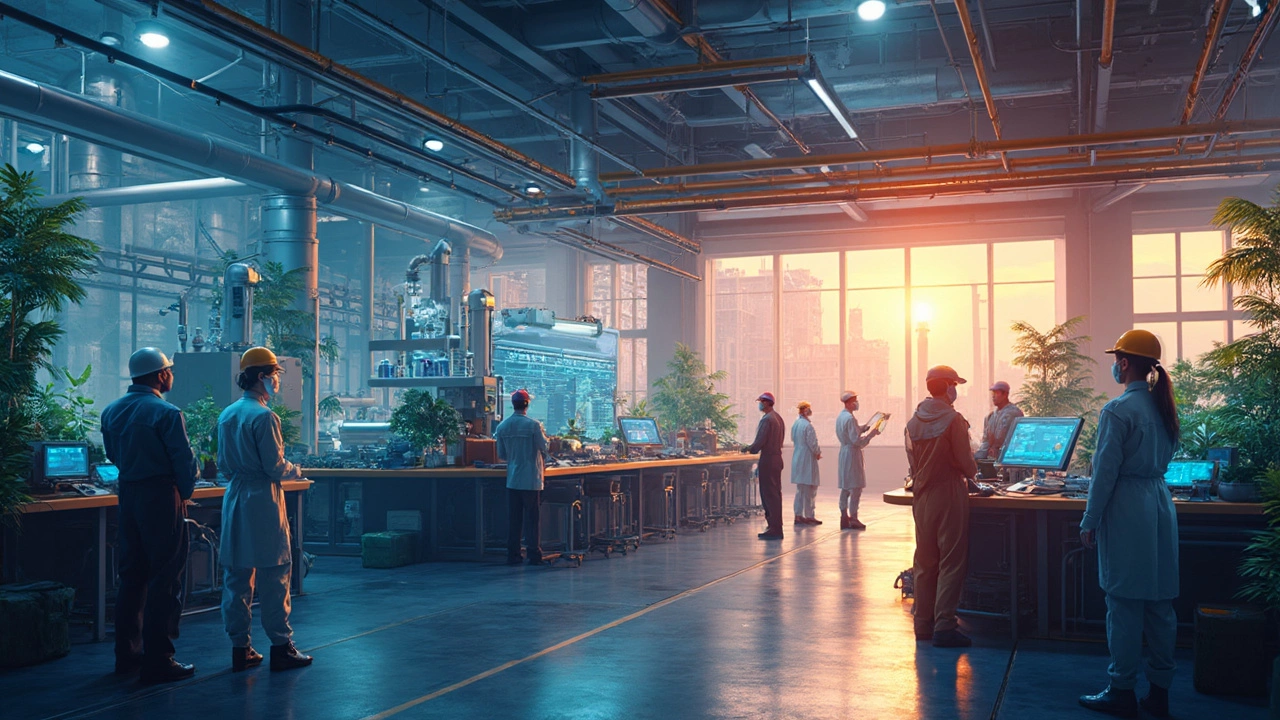Chemical Industry Outlook 2024: What Indian Manufacturers Need to Know

Prices are jumping, exports are growing, and everyone’s eyeing China-plus-one strategies—2024 is shaping up to be a wild ride for India’s chemical sector. If you run a chemical business or plan to invest, you need more than just headlines. You want to know what’s actually changing and how to navigate it.
Supply chains are still shaky after the pandemic, but Indian manufacturers are finding ways to grab a bigger share of the global market. There’s stronger demand for specialty chemicals, especially from pharma and agro sectors. This means local companies are ramping up production, not just for domestic needs but to fill gaps left by international players pulling out of China.
What’s causing all this buzz? For one thing, the Indian government is handing out incentives for local production and pushing stricter environmental rules. International buyers are loving the ‘China+1’ model, so they’re partnering more with Indian companies. Add in higher input costs and changing tech, and you get a landscape that’s both risky and full of chances to grow if you know where to look.
- Current State of India’s Chemical Industry
- Major Trends Shaping 2024
- Challenges and Risks Ahead
- Strategies for Indian Chemical Manufacturers
Current State of India’s Chemical Industry
If you look at where things stand in 2024, it’s clear India’s chemical industry is on a strong growth path. India is now the sixth-largest chemical producer in the world and the third biggest in Asia. The sector is valued at about $220 billion, and growth rates just keep beating expectations. In 2023, exports jumped by over 8%, and signs show this pace is holding steady.
Why the boost? Well, Indian manufacturers have been focusing on specialty chemicals, which now account for nearly 22% of total chemical exports. Pharma, textiles, and agriculture are the main sectors driving up demand. Big global companies are now looking to India for supply—especially as they’re moving operations away from China due to high costs and trade tensions. That means more export orders for Indian plants and more jobs in the sector. Here’s how the numbers currently look:
| Metric | 2023 Value | Growth (YoY) |
|---|---|---|
| Total Market Value (USD) | $220 Billion | ~11% |
| Export Share | $45 Billion | 8.3% |
| Specialty Chemicals Share | 22% | 2% increase |
| Sector Employment | ~2 Million | 5% increase |
One more thing—India’s government has rolled out Production Linked Incentive (PLI) schemes for chemicals, making it much easier for manufacturers to invest in new tech and push out more products. Environmental rules are getting tougher too, so there’s pressure to innovate and stick to cleaner processes. But this also gives local makers of eco-friendly chemicals a solid edge in the market.
If you’re in the industry, keeping an eye on raw material prices is key. Crude oil and petrochemical costs are still volatile, which can squeeze margins fast. On the bright side, the local customer base is huge—India’s growing population and rapid urbanization mean steady demand for everything from plastics to cleaning agents. No surprise that more young professionals and businesses are jumping into the chemical industry India scene right now.
Major Trends Shaping 2024
2024 is making waves for chemical manufacturers in India as the chemical industry India heads into new territory. The top story? A massive focus on exports. In 2023, chemical exports crossed $30 billion, and this upward push is holding steady with demand for Indian chemicals surging in Europe, the US, and Southeast Asia. International buyers want alternatives to China, and India’s stepping up.
Government policies are fueling the momentum. The Production Linked Incentive (PLI) scheme is helping mid-sized and large players invest in new tech and cut down costs. On top of that, stricter regulations around pollution and waste management are guiding companies toward greener and safer processes. This is turning out to be a win for exporters, as more global buyers look for sustainable suppliers.
Specialty chemicals are grabbing all the action—think dyes, adhesives, and ingredients for pharma and agriculture. The sector’s growing at over 10% every year, driven by rising local consumption and steady international orders. Manufacturers shifting to high-margin specialty products are pulling ahead of those dealing mainly in basic chemicals.
Let's not forget raw material supply. Fluctuating prices for crude oil and logistics hiccups are squeezing margins. Companies are moving towards ‘backward integration’—making more of their own inputs to cut costs and reduce surprises in the supply chain.
This summary table captures the top trends rocking 2024:
| Trend | What’s Happening | Impact |
|---|---|---|
| Export Growth | Demand from Europe, US, ASEAN | Higher volumes, better pricing |
| Sustainability Push | Stricter rules and global buyers’ requirements | Shift to cleaner, greener processes |
| Specialty Chemicals Boom | More players pivoting to high-value segments | Better margins and product mix |
| Raw Material Volatility | Price swings, supply disruptions | More backward integration, flexible sourcing |
| Tech Adoption | Automation, digital tools | Lower costs, improved efficiency |
Automation and digital tools are another big story. Smart manufacturing isn’t just a buzzword—B2B buyers are demanding traceability and data on every order. Companies using basic ERPs and manual paperwork are falling behind as digital-first competitors promise faster production tracking and better compliance.
If you’re looking to get ahead, learning what global customers want and investing in innovation and quality can help you grab a bigger chunk of the market. 2024 is definitely not the year to stand still.

Challenges and Risks Ahead
Running a chemical business in India during 2024 isn’t smooth sailing. Challenges are piling up faster than most of us can react, and ignoring them isn’t an option. Let’s cut through the noise and look at what’s really slowing manufacturers down this year.
- Raw Material Price Volatility: The cost of key raw materials like petrochemicals and specialty intermediates keeps swinging. For example, prices for certain solvents shot up over 35% between early 2022 and late 2023, mostly due to crude oil price changes, supply disruptions out of China, and the Russia-Ukraine war still messing with global flows.
- Regulatory Pressure: The government has rolled out new environmental standards. Plants must invest in costly tech—like zero liquid discharge—just to stay compliant. In Gujarat and Maharashtra, several smaller units have actually shut down because they couldn’t afford upgrades.
- Global Competition: China might be retreating in some segments, but they’re still dumping excess stock when they can, dragging prices down. Plus, European manufacturers are making a comeback with greener chemicals, pushing Indian producers to match or risk losing contracts.
- Logistics Hurdles: Ports are crowded and moving goods inland is slower than before. Frequent container shortages and higher ocean freight rates make exporting and importing raw materials a headache.
- Talent Crunch: It’s surprisingly tough to find qualified plant managers and safety experts. Pay scales are going up, and big companies are poaching from midsize firms, making it even harder for smaller outfits to keep their best people.
Check out some hard data for 2024 so far:
| Challenge | Current Situation (2024) |
|---|---|
| Raw material price volatility | Avg. 20-35% increase in core input costs since 2022 |
| Regulatory spending | Up to 10% of annual operating budget now goes to compliance for large firms |
| Port congestion | Average turnaround times at Mumbai, Mundra up by 15% YOY |
| Talent shortage | Vacancies in skilled roles up 18% compared to last year |
For Indian chemical manufacturers, the next few quarters are about weathering these storms without losing ground. If you want to stay in the game, it’s time to plan for these bumps, keep costs under control, and figure out how to hold onto your core talent.
Strategies for Indian Chemical Manufacturers
If you’re in the Indian chemical game, 2024 is all about playing it smarter. Instead of just stretching production, companies are investing in tech, chasing global quality standards, and finding ways to lower costs without cutting corners. Let’s break down what's working for the leaders right now.
Chemical industry India manufacturers have started to go digital big time. Smart manufacturing—think all those sensors, data dashboards, and automated mixers—does more than just look cool. It actually keeps wastage in check and helps track quality in real time. Reliance Industries rolled out real-time production monitoring at four plants in late 2023, saving an average of 7% in energy and reducing downtime by over 12% per plant.
- Collaborate Local, Export Wide: Companies that tie up with Indian specialty startups are finding ways to get new ideas to market fast. At the same time, everyone’s pushing hard to get their products certified for European and American markets—because that’s where the big margins are.
- Lean Into Compliance: Going green isn’t just a checkbox; stricter pollution and safety standards are here to stay. Firms investing in zero liquid discharge and energy-efficient equipment are jumping regulatory hoops before they become headaches.
- Secure Raw Materials: The cost and availability of raw materials fluctuated wildly in 2023. It pays to lock in contracts or even backward integrate. Companies like Deepak Nitrite have invested in their own feedstock projects, which means fewer surprises when global prices shift.
- Upskill Your Team: Stuff like automation and process optimization only work if staff know how to use them. DCM Shriram started monthly digital training sessions and cut error rates by 18% within six months.
Here’s a snap of what top chemical manufacturers in India are focusing on (based on industry surveys and business reports from Q1 2024):
| Strategy | % of Top 100 Companies Implementing |
|---|---|
| Advanced Process Automation | 64% |
| Backward Integration for Raw Materials | 39% |
| ESG (Environment, Social, Governance) Initiatives | 54% |
| New Export Certifications | 41% |
| Skills and Training Programs | 45% |
If you’re thinking long-term, keep an eye out for special economic zones popping up near ports. The closer you are to efficient logistics, the easier it gets to manage exports and reduce supply chain hiccups. Doing all this doesn’t just boost profits—it sets you up to be way more resilient, whatever surprises 2024 throws out next.





